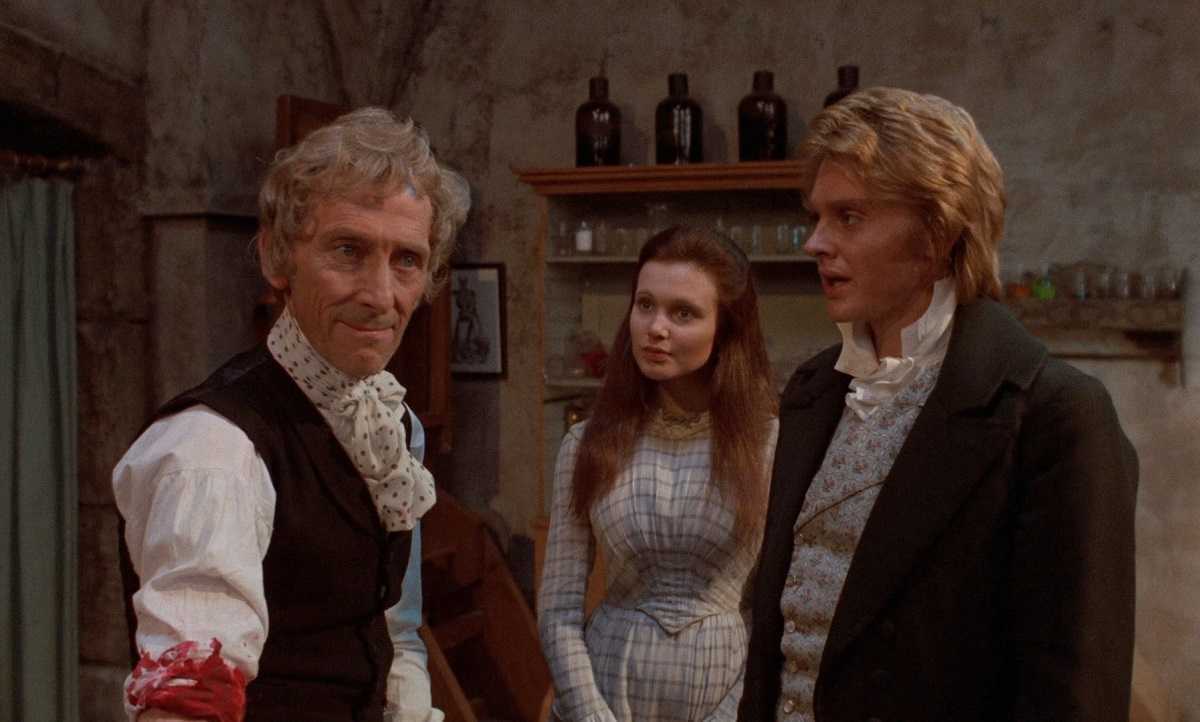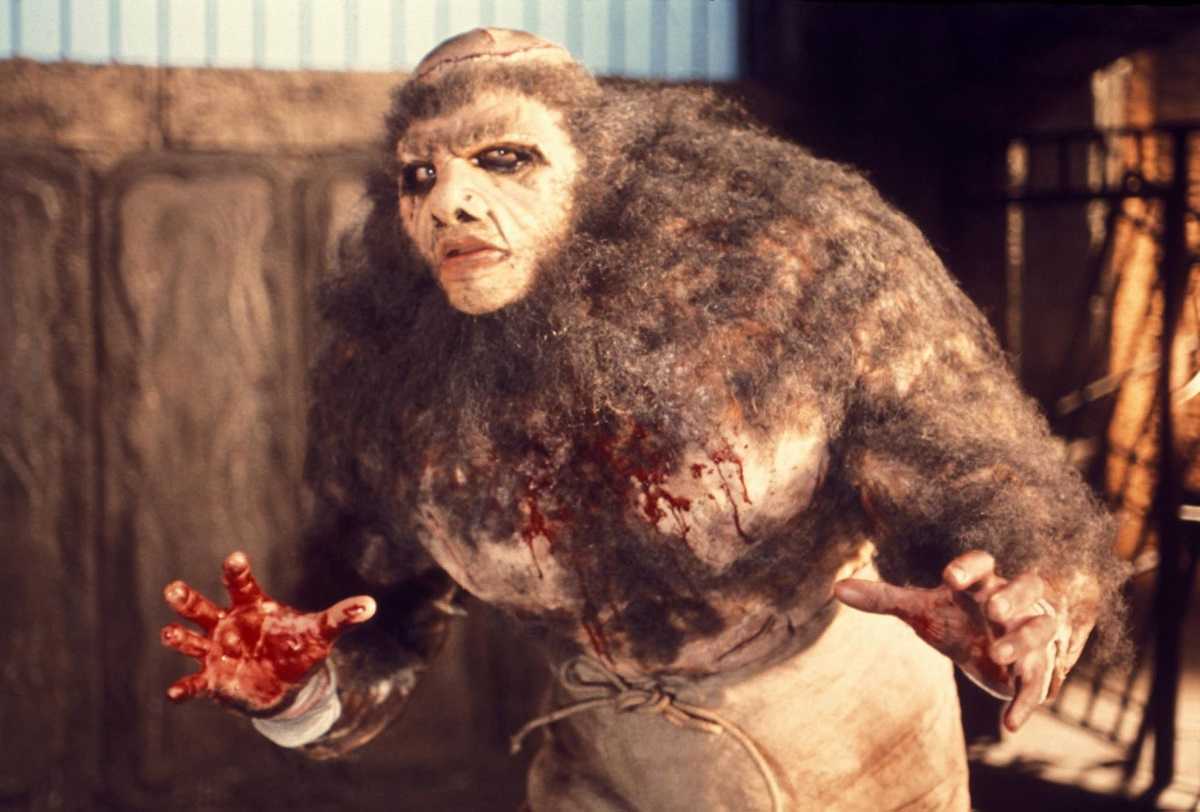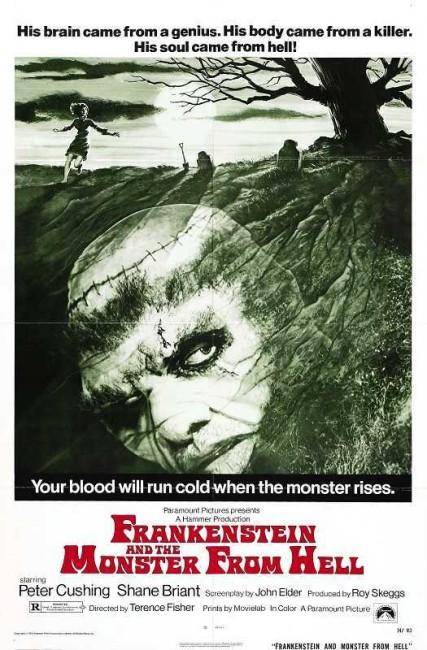UK. 1974.
Crew
Director – Terence Fisher, Screenplay – John Elder [Anthony Hinds], Producer – Roy Skeggs, Photography – Brian Probyn, Music – James Bernard, Music Supervisor – Philip Martell, Makeup – Eddie Knight, Art Direction – Scott MacGregor. Production Company – Hammer Films.
Cast
Peter Cushing (Baron Victor Frankenstein/Dr Victor), Shane Briant (Simon Helder), Madeline Smith (Sarah Klauss), Dave Prowse (Monster), John Stratton (Director Adolf Klauss), Charles Lloyd Pack (Professor Durendel), Patrick Troughton (Bodysnatcher), Philip Voss (Ernst), Chris Cunningham (Hans), Clifford Mollison (Judge), Norman Mitchell (Police Sergeant), Sydney Bromley (Muller), Bernard Lee (Tarmut)
Plot
Simon Helder, a medical student and follower of the theories of Baron Frankenstein, is arrested for body snatching. He is sentenced to an asylum. There he meets the asylum’s doctor Victor and realises it is none other than Frankenstein who has faked his own death and blackmailed the corrupt asylum head Klauss into sheltering him under an assumed name. Frankenstein makes Simon his assistant to take over medical duties and free him up for experiments. When Simon discovers that Frankenstein is building a creature out of the hulking ape-like body of a former inmate, he agrees to perform surgical duties for Frankenstein whose own hands have been badly damaged in a fire. As Simon discovers, Frankenstein is piecing together his creature with the eyes, hands and brain of other inmates who have all suspiciously died just when their body parts were needed.
Frankenstein and the Monster from Hell was the seventh and final of Hammer’s Frankenstein films. Hammer had made The Curse of Frankenstein (1957), their reworking of Mary Shelley’s Frankenstein (1818), sixteen years earlier. The English horror scene exploded onto the world stage from there and Hammer went onto revisit various other horror classics. During their reign at the box-office – from 1957 until the mid-1970s not long after this – Hammer would make five follow-ups to Curse with The Revenge of Frankenstein (1958), The Evil of Frankenstein (1964), Frankenstein Created Woman (1967), Frankenstein Must Be Destroyed (1969) and Frankenstein and the Monster from Hell, all featuring Hammer staple Peter Cushing as Baron Frankenstein.
The 1970s brought new blood into Hammer and they started trying to tap the youth market by spicing their horror films up with more sexual content and introducing younger leads. During this time, they remade Curse with a more comedic focus as The Horror of Frankenstein (1970) wherein Peter Cushing was recast with a younger actor Ralph Bates. With the flop of The Horror of Frankenstein, Hammer made one last effort, Frankenstein and the Monster from Hell. This returned to the continuity of the other films and brought back Peter Cushing, along with director Terence Fisher who had directed all the other Frankenstein films with the exception of Evil and Horror. (Fisher had been absent from screens since 1969 due to a motorcycle accident. Alas, Frankenstein and the Monster from Hell would be his last film and he died six years later in 1980 from a heart-attack).
Frankenstein and the Monster from Hell was also the last Hammer film made in the traditional style where all the elements from the classic Frankenstein films were at play. Hammer made a couple of other horror films subsequently before closing up shop – The Legend of the 7 Golden Vampires (1974) and To the Devil a Daughter (1976) – but these were either modernisations that abandoned the classic style or were attempting to compensate for the absence of key players.
Frankenstein and the Monster from Hell was also the very last film directed by Terence Fisher, one of the key Hammer creative personnel since the beginning – Fisher was aged 70 at the time and died of a heart-attack a few years later in 1980. It was also the last Hammer script by Anthony Hinds (under his usual John Elder pseudonym), son of the founder of Hammer. It is also the last great film that Hammer ever made.

As though aware that this would be one of the studio’s last parting shots, everyone present seems to put all they have into Frankenstein and the Monster from Hell. The sets are the beautifully lush ones they were in the Hammer heyday rather than the cheaper ones of some of the later films. Peter Cushing’s co-star is the incredibly handsome Shane Briant – an actor who appeared in three other films for Hammer during the early 1970s – who plays with a wonderfully haughty and aristocratic arrogance.
Throughout, Peter Cushing is at his icily arrogant best. Terence Fisher gives Cushing a great entrance, he abruptly turning up in the midst of where the warders are torturing Shane Briant with a firehose in front of a crowd of jeering inmates, alive despite the claim that he is dead given by the director of the asylum, taking command, dismissing the inmates and warders for making a spectacle, and going on to reprimand the director and blackmailing him into compliance.
One of the more interesting aspects is the portrayal of the monster. Rather than the hulking resurrected figure it is usually portrayed as, The Monster here, played by none other than Dave Prowse, later Darth Vader in Star Wars (1977) and sequels, is seen as more ape-like than human. At one point, he is even referred to as a Neanderthal. The monster makeup is probably the best it was out of all the Hammer Frankenstein films, even if it feels difficult to believe that such a hairy ape-like creature is something that originally started out as a human. Dave Prowse’s performance also comes with something of the pathos of Boris Karloff’s performance in the original Frankenstein (1931) with haunting scenes where he tries to play the violin but crushes it in frustration, or where he is writing formulas on a blackboard and the numbers suddenly start to trail off.

There is a fabulous aerial image down on the monster digging up the graveyard in the middle of a lightning storm, using one of the crosses as a shovel. There is also the grisly level of gore than Terence Fisher introduced in Frankenstein Must Be Destroyed. We get scenes of Shane Briant cutting open a head with a saw, removing the dome and then gingerly cutting out and removing the brain. There seems no more effective an image of the Baron’s callousness than the scene where he removes the brain, crassly dumps it into a pan of bloody rags on the floor and then moments later accidentally kicks the pan over with his foot.
On the minus side, Monster from Hell seems much slower in pace than the majority of the other Hammer Frankenstein films. This does make it more dependent on mood – the dark looming sets of the asylum adding much in this regard. The story is fine up until around the point where Peter Cushing announces his plan to cure the rejection of the brain by the monster’s body by for some reason mating him with Madeline Smith – sensibly, the logic of doing this is not debated any more than that. Mostly it seems a bizarre left field piece of plotting to allow Shane Briant to finally rebel against Peter Cushing’s plans in order to save Madeline Smith. This is one Frankenstein film that surprisingly ends with the Baron not killed off.
Terence Fisher’s other genre films are:– the sf films Four Sided Triangle (1953) and Spaceways (1953), The Curse of Frankenstein (1957), Dracula/The Horror of Dracula (1958), The Revenge of Frankenstein (1958), The Hound of the Baskervilles (1959), The Man Who Could Cheat Death (1959), The Mummy (1959), The Stranglers of Bombay (1959), The Brides of Dracula (1960), The Two Faces of Dr. Jekyll (1960), The Curse of the Werewolf (1961), The Phantom of the Opera (1962), The Gorgon (1964), Dracula – Prince of Darkness (1966), Frankenstein Created Woman (1967), The Devil Rides Out/The Devil’s Bride (1968) and Frankenstein Must Be Destroyed (1969), all for Hammer. Outside of Hammer, Fisher has made the Old Dark House comedy The Horror of It All (1964) and the alien invasion films The Earth Dies Screaming (1964), Island of Terror (1966) and Night of the Big Heat (1967).
Trailer here


